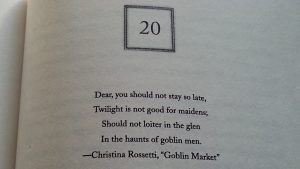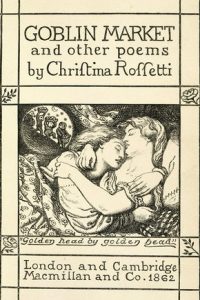 It’s the eve of All Hallows’ Eve, and if I had to choose one poem (Only one? Why do I do this to myself?) to read aloud tomorrow, it would be Christina Rossetti’s “Goblin Market” (1862). In fact, if I had to choose one poem that represents everything I love about Victorian literature, it would be this one. If you haven’t read it, Google it and read it now. Seriously. It’s amazing. If you don’t have time to read both the poem and this blog post, please read the poem instead!
It’s the eve of All Hallows’ Eve, and if I had to choose one poem (Only one? Why do I do this to myself?) to read aloud tomorrow, it would be Christina Rossetti’s “Goblin Market” (1862). In fact, if I had to choose one poem that represents everything I love about Victorian literature, it would be this one. If you haven’t read it, Google it and read it now. Seriously. It’s amazing. If you don’t have time to read both the poem and this blog post, please read the poem instead!
Rossetti’s “Goblin Market” is the epigraph to Chapter 20 of Bear No Malice for reasons I won’t go into because I don’t want to spoil any secrets for readers. I also teach this poem in every English course I can manage to sneak it into, especially Nineteenth-Century Lit and Children’s Lit. It’s not technically children’s literature, despite the nursery-rhyme quality of the short, sing-song lines. It’s a cautionary fairy tale with fantasy elements: goblins try to sell their tempting fruit to young maidens, who must not eat it. If they do, serious consequences ensue. This poem has been interpreted through the lenses of sexuality, commerce, consumption (in every sense of the word), sin and redemption, sickness and health, and many more. But no attempt to explain or categorize this poem can capture the magic of it, even though readers and academics have tried for more than a century.
 I could go on and on about the brilliant Christina Rossetti, who is often overshadowed by her more famous brother Dante Gabriel Rossetti and the Pre-Raphaelite Brotherhood. But this blog post is supposed to be about Bear No Malice, which is historical fiction, not a poem, fairy tale, or fantasy novel. As I mentioned in my previous post, though, my protagonists see the world through the lens of the literary works they’ve read, and that includes fairy tales. For example, when Tom first meets siblings Simon and Miranda, he thinks of them as grown-up versions of Hansel and Gretel and sees no room for himself in their lives except as a villain.
I could go on and on about the brilliant Christina Rossetti, who is often overshadowed by her more famous brother Dante Gabriel Rossetti and the Pre-Raphaelite Brotherhood. But this blog post is supposed to be about Bear No Malice, which is historical fiction, not a poem, fairy tale, or fantasy novel. As I mentioned in my previous post, though, my protagonists see the world through the lens of the literary works they’ve read, and that includes fairy tales. For example, when Tom first meets siblings Simon and Miranda, he thinks of them as grown-up versions of Hansel and Gretel and sees no room for himself in their lives except as a villain.
If you love fairy-tale retellings or novels with fairy-tale elements, I highly recommend Kate Morton’s books, especially The Forgotten Garden and The Distant Hours. If you prefer a darker, more sinister tone to your fairy tales, try Dana Chamblee Carpenter’s Bohemian Gospel or Melissa Albert’s The Hazel Wood. And if you don’t have time to read a whole novel, you can’t go wrong with these short stories and revisionist fairy tales: Tanith Lee’s “When the Clock Strikes” and Angela Carter’s “The Company of Wolves.”
A new novel that I’ve ordered but haven’t read yet is Rena Budner Rossner’s Sisters of the Winter Wood, a retelling of Rossetti’s “Goblin Market” that’s been getting lots of buzz and great reviews. I am so excited for this one that I’ve been practically pouncing on my poor mail carrier every time she arrives on my doorstep!
If you’ve read any great novels with fairy-tale elements and have recommendations for me, please mention them in the comments. And happy All Hallows’ Eve Eve!